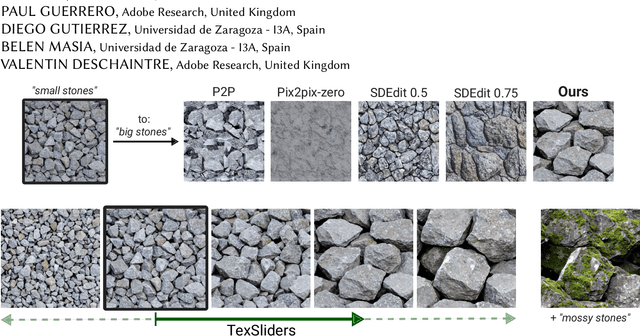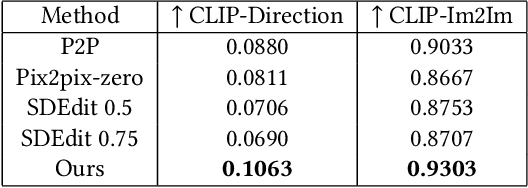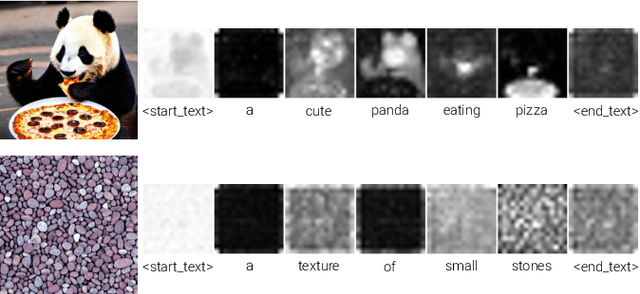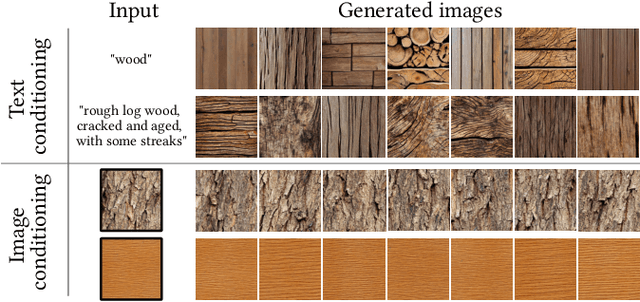Paul Guerrero
3D-Fixup: Advancing Photo Editing with 3D Priors
May 15, 2025Abstract:Despite significant advances in modeling image priors via diffusion models, 3D-aware image editing remains challenging, in part because the object is only specified via a single image. To tackle this challenge, we propose 3D-Fixup, a new framework for editing 2D images guided by learned 3D priors. The framework supports difficult editing situations such as object translation and 3D rotation. To achieve this, we leverage a training-based approach that harnesses the generative power of diffusion models. As video data naturally encodes real-world physical dynamics, we turn to video data for generating training data pairs, i.e., a source and a target frame. Rather than relying solely on a single trained model to infer transformations between source and target frames, we incorporate 3D guidance from an Image-to-3D model, which bridges this challenging task by explicitly projecting 2D information into 3D space. We design a data generation pipeline to ensure high-quality 3D guidance throughout training. Results show that by integrating these 3D priors, 3D-Fixup effectively supports complex, identity coherent 3D-aware edits, achieving high-quality results and advancing the application of diffusion models in realistic image manipulation. The code is provided at https://3dfixup.github.io/
ObjectMover: Generative Object Movement with Video Prior
Mar 11, 2025Abstract:Simple as it seems, moving an object to another location within an image is, in fact, a challenging image-editing task that requires re-harmonizing the lighting, adjusting the pose based on perspective, accurately filling occluded regions, and ensuring coherent synchronization of shadows and reflections while maintaining the object identity. In this paper, we present ObjectMover, a generative model that can perform object movement in highly challenging scenes. Our key insight is that we model this task as a sequence-to-sequence problem and fine-tune a video generation model to leverage its knowledge of consistent object generation across video frames. We show that with this approach, our model is able to adjust to complex real-world scenarios, handling extreme lighting harmonization and object effect movement. As large-scale data for object movement are unavailable, we construct a data generation pipeline using a modern game engine to synthesize high-quality data pairs. We further propose a multi-task learning strategy that enables training on real-world video data to improve the model generalization. Through extensive experiments, we demonstrate that ObjectMover achieves outstanding results and adapts well to real-world scenarios.
VideoHandles: Editing 3D Object Compositions in Videos Using Video Generative Priors
Mar 03, 2025Abstract:Generative methods for image and video editing use generative models as priors to perform edits despite incomplete information, such as changing the composition of 3D objects shown in a single image. Recent methods have shown promising composition editing results in the image setting, but in the video setting, editing methods have focused on editing object's appearance and motion, or camera motion, and as a result, methods to edit object composition in videos are still missing. We propose \name as a method for editing 3D object compositions in videos of static scenes with camera motion. Our approach allows editing the 3D position of a 3D object across all frames of a video in a temporally consistent manner. This is achieved by lifting intermediate features of a generative model to a 3D reconstruction that is shared between all frames, editing the reconstruction, and projecting the features on the edited reconstruction back to each frame. To the best of our knowledge, this is the first generative approach to edit object compositions in videos. Our approach is simple and training-free, while outperforming state-of-the-art image editing baselines.
ShapeLib: designing a library of procedural 3D shape abstractions with Large Language Models
Feb 13, 2025Abstract:Procedural representations are desirable, versatile, and popular shape encodings. Authoring them, either manually or using data-driven procedures, remains challenging, as a well-designed procedural representation should be compact, intuitive, and easy to manipulate. A long-standing problem in shape analysis studies how to discover a reusable library of procedural functions, with semantically aligned exposed parameters, that can explain an entire shape family. We present ShapeLib as the first method that leverages the priors of frontier LLMs to design a library of 3D shape abstraction functions. Our system accepts two forms of design intent: text descriptions of functions to include in the library and a seed set of exemplar shapes. We discover procedural abstractions that match this design intent by proposing, and then validating, function applications and implementations. The discovered shape functions in the library are not only expressive but also generalize beyond the seed set to a full family of shapes. We train a recognition network that learns to infer shape programs based on our library from different visual modalities (primitives, voxels, point clouds). Our shape functions have parameters that are semantically interpretable and can be modified to produce plausible shape variations. We show that this allows inferred programs to be successfully manipulated by an LLM given a text prompt. We evaluate ShapeLib on different datasets and show clear advantages over existing methods and alternative formulations.
GANFusion: Feed-Forward Text-to-3D with Diffusion in GAN Space
Dec 21, 2024Abstract:We train a feed-forward text-to-3D diffusion generator for human characters using only single-view 2D data for supervision. Existing 3D generative models cannot yet match the fidelity of image or video generative models. State-of-the-art 3D generators are either trained with explicit 3D supervision and are thus limited by the volume and diversity of existing 3D data. Meanwhile, generators that can be trained with only 2D data as supervision typically produce coarser results, cannot be text-conditioned, or must revert to test-time optimization. We observe that GAN- and diffusion-based generators have complementary qualities: GANs can be trained efficiently with 2D supervision to produce high-quality 3D objects but are hard to condition on text. In contrast, denoising diffusion models can be conditioned efficiently but tend to be hard to train with only 2D supervision. We introduce GANFusion, which starts by generating unconditional triplane features for 3D data using a GAN architecture trained with only single-view 2D data. We then generate random samples from the GAN, caption them, and train a text-conditioned diffusion model that directly learns to sample from the space of good triplane features that can be decoded into 3D objects.
* https://ganfusion.github.io/
Pattern Analogies: Learning to Perform Programmatic Image Edits by Analogy
Dec 17, 2024Abstract:Pattern images are everywhere in the digital and physical worlds, and tools to edit them are valuable. But editing pattern images is tricky: desired edits are often programmatic: structure-aware edits that alter the underlying program which generates the pattern. One could attempt to infer this underlying program, but current methods for doing so struggle with complex images and produce unorganized programs that make editing tedious. In this work, we introduce a novel approach to perform programmatic edits on pattern images. By using a pattern analogy -- a pair of simple patterns to demonstrate the intended edit -- and a learning-based generative model to execute these edits, our method allows users to intuitively edit patterns. To enable this paradigm, we introduce SplitWeave, a domain-specific language that, combined with a framework for sampling synthetic pattern analogies, enables the creation of a large, high-quality synthetic training dataset. We also present TriFuser, a Latent Diffusion Model (LDM) designed to overcome critical issues that arise when naively deploying LDMs to this task. Extensive experiments on real-world, artist-sourced patterns reveals that our method faithfully performs the demonstrated edit while also generalizing to related pattern styles beyond its training distribution.
Motion Modes: What Could Happen Next?
Nov 29, 2024Abstract:Predicting diverse object motions from a single static image remains challenging, as current video generation models often entangle object movement with camera motion and other scene changes. While recent methods can predict specific motions from motion arrow input, they rely on synthetic data and predefined motions, limiting their application to complex scenes. We introduce Motion Modes, a training-free approach that explores a pre-trained image-to-video generator's latent distribution to discover various distinct and plausible motions focused on selected objects in static images. We achieve this by employing a flow generator guided by energy functions designed to disentangle object and camera motion. Additionally, we use an energy inspired by particle guidance to diversify the generated motions, without requiring explicit training data. Experimental results demonstrate that Motion Modes generates realistic and varied object animations, surpassing previous methods and even human predictions regarding plausibility and diversity. Project Webpage: https://motionmodes.github.io/
SuperGaussian: Repurposing Video Models for 3D Super Resolution
Jun 04, 2024



Abstract:We present a simple, modular, and generic method that upsamples coarse 3D models by adding geometric and appearance details. While generative 3D models now exist, they do not yet match the quality of their counterparts in image and video domains. We demonstrate that it is possible to directly repurpose existing (pretrained) video models for 3D super-resolution and thus sidestep the problem of the shortage of large repositories of high-quality 3D training models. We describe how to repurpose video upsampling models, which are not 3D consistent, and combine them with 3D consolidation to produce 3D-consistent results. As output, we produce high quality Gaussian Splat models, which are object centric and effective. Our method is category agnostic and can be easily incorporated into existing 3D workflows. We evaluate our proposed SuperGaussian on a variety of 3D inputs, which are diverse both in terms of complexity and representation (e.g., Gaussian Splats or NeRFs), and demonstrate that our simple method significantly improves the fidelity of the final 3D models. Check our project website for details: supergaussian.github.io
TexSliders: Diffusion-Based Texture Editing in CLIP Space
May 01, 2024



Abstract:Generative models have enabled intuitive image creation and manipulation using natural language. In particular, diffusion models have recently shown remarkable results for natural image editing. In this work, we propose to apply diffusion techniques to edit textures, a specific class of images that are an essential part of 3D content creation pipelines. We analyze existing editing methods and show that they are not directly applicable to textures, since their common underlying approach, manipulating attention maps, is unsuitable for the texture domain. To address this, we propose a novel approach that instead manipulates CLIP image embeddings to condition the diffusion generation. We define editing directions using simple text prompts (e.g., "aged wood" to "new wood") and map these to CLIP image embedding space using a texture prior, with a sampling-based approach that gives us identity-preserving directions in CLIP space. To further improve identity preservation, we project these directions to a CLIP subspace that minimizes identity variations resulting from entangled texture attributes. Our editing pipeline facilitates the creation of arbitrary sliders using natural language prompts only, with no ground-truth annotated data necessary.
PPSURF: Combining Patches and Point Convolutions for Detailed Surface Reconstruction
Jan 16, 2024Abstract:3D surface reconstruction from point clouds is a key step in areas such as content creation, archaeology, digital cultural heritage, and engineering. Current approaches either try to optimize a non-data-driven surface representation to fit the points, or learn a data-driven prior over the distribution of commonly occurring surfaces and how they correlate with potentially noisy point clouds. Data-driven methods enable robust handling of noise and typically either focus on a global or a local prior, which trade-off between robustness to noise on the global end and surface detail preservation on the local end. We propose PPSurf as a method that combines a global prior based on point convolutions and a local prior based on processing local point cloud patches. We show that this approach is robust to noise while recovering surface details more accurately than the current state-of-the-art. Our source code, pre-trained model and dataset are available at: https://github.com/cg-tuwien/ppsurf
* Published in Computer Graphics Forum (Jan 2024): https://onlinelibrary.wiley.com/doi/10.1111/cgf.15000
 Add to Chrome
Add to Chrome Add to Firefox
Add to Firefox Add to Edge
Add to Edge